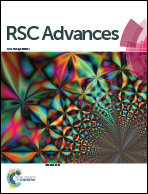Rigid thermosetting epoxy/multi-walled carbon nanotube foams with enhanced conductivity originated from a flow-induced concentration effect†
Abstract
Herein, multi-walled carbon nanotube (MWCNT) reinforced rigid epoxy foams were innovatively prepared using expandable microspheres. A two-step technique, including prepolymerization and consecutive foaming, was employed to avoid the thermal degradation of epoxy due to the uncontrolled violent curing reaction. The effects of foaming on the MWCNT inter-connectivity, electrical percolation threshold, and through-plane electrical conductivity were investigated. Moderately foamed epoxy/MWCNT composites were confirmed to have better conductivity than their solid counterparts at the same MWCNT content. An effect we called flow-induced concentration increases the inter-connectivity by separating MWCNTs from a flowing matrix caused by thermally triggered expansion of microspheres, and changes the MWCNT distribution. For the foamed composites with 2 wt% microspheres, the electrical percolation threshold is approximately 0.3 wt% and the conductivity is obviously higher than that of the solid counterpart. Relationships between microstructures and conductivities were also discussed. The mechanical property and cellular structures of conductive foams obtained under different foaming temperatures, prepolymerization time, microsphere and MWCNT contents were respectively evaluated. All the results reveal that lightweight conductive epoxy foams with lower filler content and enhanced conductivity can be fabricated for applications in electronics, automobiles, and aerospace.


 Please wait while we load your content...
Please wait while we load your content...